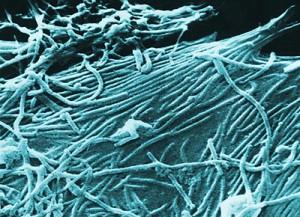BioterrorismProgress made toward a vaccine for Ebola
Ebola is one of the most lethal, naturally occurring pathogens on earth, killing up to 90 percent of its victims, and producing a terrifying constellation of symptoms known as hemorrhagic fever; scientists have now made significant progress toward a vaccine against the deadly virus – and this Ebola vaccine could be stockpiled for use in the United States, should the country fall victim to a natural outbreak or a bioterrorism event in which a weaponized strain of the virus were unleashed on soldiers or the public

Photomicrographic image of the Ebola virus // Source: konspiracniteorie.cz
On 26 August 1976 a time bomb exploded in Yambuku, a remote village in Zaire (now the Democratic Republic of the Congo). A threadlike virus known as Ebola had emerged, soon earning a distinction as one of the most lethal, naturally occurring pathogens on earth, killing up to 90 percent of its victims, and producing a terrifying constellation of symptoms known as hemorrhagic fever.
Now, Charles Arntzen, a researcher at the Biodesign Institute at Arizona State University, along with colleagues from ASU, the University of Arizona College of Medicine-Phoenix, and the United States Army Medical Research Institute of Infectious Diseases, Fort Detrick, Maryland, have made progress toward a vaccine against the deadly virus.
An Arizona State University release reports that the group’s research results appear in today’s issue of the Proceedings of the National Academy of Sciences, along with a companion paper by their collaborators at Mapp Pharmaceuticals in San Diego, California, led by Larry Zeitlin.
Arntzen’s group demonstrated that a plant-derived vaccine for Ebola provided strong immunological protection in a mouse model.
If early efforts bear fruit, an Ebola vaccine could be stockpiled for use in the United States, should the country fall victim to a natural outbreak or a bioterrorism event in which a weaponized strain of the virus were unleashed on soldiers or the public.
To date, Ebola outbreaks have been rare. For researchers like Arntzen however, this presents a challenge: “With other lethal viruses like HIV there is a common pattern of occurrence, allowing for vaccine testing. For example, an AIDS vaccine study is now underway at two locations in Thailand, which were chosen because of a current high incidence of the disease.”
By contrast, Ebola events are fleeting, episodic and largely unpredictable. For this reason, Arntzen stresses that an Ebola vaccine would most likely not be used prophylactically — that is, as a means of protecting large populations, as in the case of common vaccines against diseases like influenza or polio. Instead, the idea is to have a sizeable store of the vaccine on hand in the event of a sudden outbreak, either natural or nefarious.
A killer up close
Ebola belongs to a family of viruses known as filoviridae, which take their name from their serpentine, filamentous structure. Filoviridae fall into two broad categories known as Ebola-like and Marburg-like viruses.
In the original Ebola outbreak in Yambuku, situated along the Ebola River, 280 of the 318 identified cases died. Soon thereafter,
